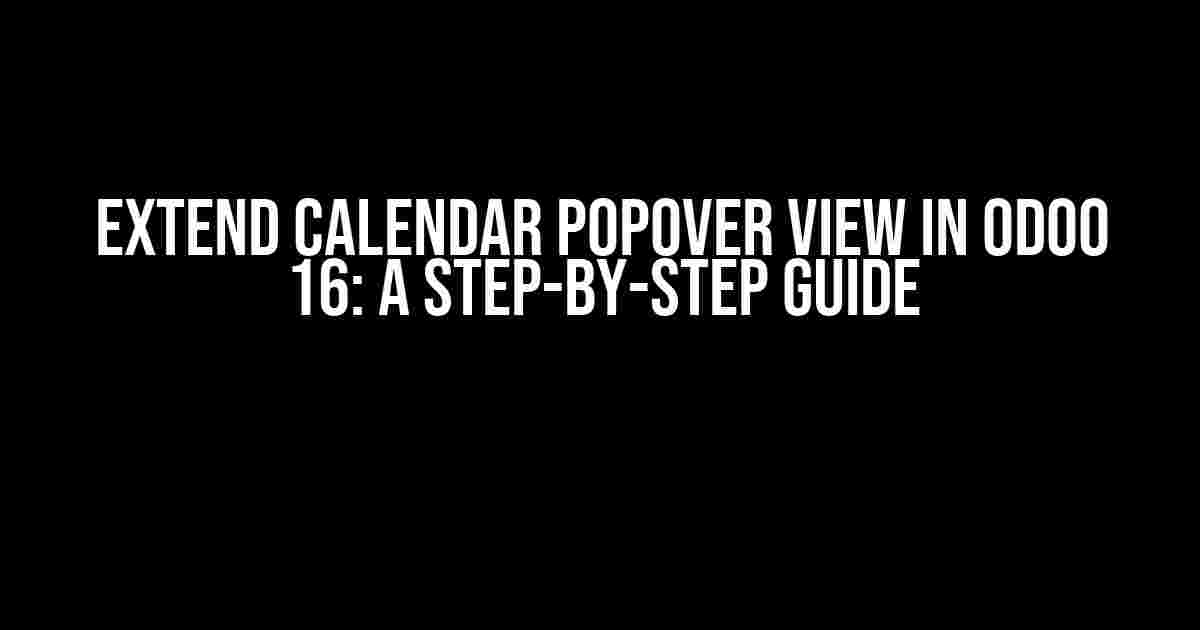Ongoing projects and tasks can get overwhelming, and having a clear calendar view is essential for efficient project management. Odoo 16 provides an excellent calendar view, but sometimes, we need to customize it to fit our specific needs. In this article, we’ll explore how to extend the calendar popover view in Odoo 16, giving you the flexibility to tailor it to your requirements.
Prerequisites
- Ongoing Odoo 16 installation
- Basic knowledge of Python, HTML, and CSS
- Familiarity with Odoo’s ORM and QWeb
Understanding the Calendar Popover View
The calendar popover view in Odoo 16 is a fantastic feature that provides a quick overview of events and tasks. By default, it displays essential information such as event title, start and end dates, and attendees. However, you might want to add custom fields, change the layout, or modify the behavior to suit your specific needs.
Default Calendar Popover View Structure
<records id="calendar.getView">
<element name="calendar">
<t t-extend="calendar.Calendar">
<t t-set="template" t-value="calendar.CalendarView">
<div class="popover">
<!-- content goes here -->
</div>
</t>
</t>
</element>
</records>
In the above code snippet, we have the basic structure of the calendar popover view. The `
Extending the Calendar Popover View
To extend the calendar popover view, we’ll create a custom module and add our customizations to the existing view.
Step 1: Create a Custom Module
Create a new directory for your custom module, and inside it, create a `__init__.py` file and a `views` directory.
my_module/ __init__.py views/ __init__.py calendar_view.xml
In the `__init__.py` file, add the following code to initialize your module:
from odoo import models, _
def register():
_logger = _logger.getLogger(__name__)
_logger.info('Registering my_module')
register()
Step 2: Create a Custom XML File
In the `views` directory, create a new file called `calendar_view.xml`. This file will contain our customizations to the calendar popover view.
<?xml version="1.0" encoding="utf-8"?>
<odoo>
<data>
<!-- extend the calendar view -->
<t t-extend="calendar.Calendar">
<t t-set="template" t-value="my_module.MyCalendarView">
<div class="popover">
<!-- custom content goes here -->
</div>
</t>
</t>
</data>
</odoo>
In this code snippet, we’re extending the calendar view and setting our custom template to `my_module.MyCalendarView`.
Step 3: Define the Custom Template
In the same `calendar_view.xml` file, add the following code to define our custom template:
<t t-name="my_module.MyCalendarView">
<div class="popover">
<h2><t t-esc="event.name"/></h2>
<ul>
<li><t t-esc="event.start"/> - <t t-esc="event.stop"/></li>
<li><t t-esc="event.description"/></li>
<!-- add custom fields or content here -->
</ul>
</div>
</t>
In this code snippet, we’re defining our custom template `my_module.MyCalendarView`. We’re using `t-esc` to display event information, and we can add custom fields or content as needed.
Step 4: Update the Calendar View
Edit the `calendar.py` file in the Odoo `addons/calendar` directory and update the `Calendar` class to use our custom template:
class Calendar(models.Model):
_inherit = 'calendar.event'
def get_popup_view(self):
return {
'name': _('Event'),
'type': 'ir.actions.act_window',
'view_mode': 'form',
'res_model': 'calendar.event',
'view_id': self.env.ref('my_module.my_calendar_view').id,
'target': 'new'
}
In this code snippet, we’re updating the `get_popup_view` method to use our custom template `my_module.my_calendar_view`.
Testing and Deployment
Restart your Odoo server, and then go to the calendar view. You should see your custom template in action.
Before deploying your custom module to production, make sure to test it thoroughly to ensure it doesn’t break any existing functionality.
Conclusion
Extending the calendar popover view in Odoo 16 is a straightforward process that requires basic knowledge of Python, HTML, and CSS. By following these steps, you can tailor the calendar view to your specific needs, adding custom fields, modifying the layout, or changing the behavior to suit your requirements.
Remeber to test and deploy your custom module with caution, and don’t hesitate to reach out to the Odoo community if you encounter any issues.
| Module | Description |
|---|---|
| Custom module to extend the calendar popover view | |
| calendar | Odoo’s built-in calendar module |
By extending the calendar popover view, you can unlock new possibilities for efficient project management and improve your overall Odoo experience.
FAQs
-
Q: What is the calendar popover view in Odoo 16?
A: The calendar popover view in Odoo 16 is a feature that provides a quick overview of events and tasks in a calendar format.
-
Q: How do I extend the calendar popover view in Odoo 16?
A: You can extend the calendar popover view by creating a custom module, defining a custom template, and updating the calendar view to use your custom template.
-
Q: What are the prerequisites for extending the calendar popover view?
A: You need an ongoing Odoo 16 installation, basic knowledge of Python, HTML, and CSS, and familiarity with Odoo’s ORM and QWeb.
By following this comprehensive guide, you should be able to extend the calendar popover view in Odoo 16 and customize it to fit your specific needs. Happy coding!
Here are the 5 Questions and Answers about “Extend Calendar Popover View in Odoo 16” in a creative tone and voice:
Frequently Asked Questions
Got questions about extending the calendar popover view in Odoo 16? We’ve got the answers!
How do I extend the calendar popover view in Odoo 16?
To extend the calendar popover view in Odoo 16, you’ll need to create a custom module and inherit the original calendar view. From there, you can add or modify fields and widgets to suit your needs. Don’t forget to update the XML file to reflect your changes!
What are the benefits of extending the calendar popover view in Odoo 16?
By extending the calendar popover view, you can customize the user experience, add new features, and improve the overall functionality of your Odoo 16 calendar. This can include adding custom fields, widgets, or even integrating with other Odoo modules. The possibilities are endless!
Can I add custom fields to the calendar popover view in Odoo 16?
Absolutely! You can add custom fields to the calendar popover view by defining them in your custom module’s XML file. Just remember to update the view’s architecture and adjust the field’s properties to fit your needs. Easy peasy!
How do I update the XML file to reflect my changes to the calendar popover view?
To update the XML file, you’ll need to modify the view’s architecture and add or modify the necessary elements. This can include adding new fields, widgets, or attributes to the view. Don’t forget to restart your Odoo server and update your module after making changes to the XML file!
Are there any specific considerations I should keep in mind when extending the calendar popover view in Odoo 16?
Yes, indeed! When extending the calendar popover view, be mindful of the view’s inheritance, XML syntax, and module dependencies. Additionally, make sure to test your changes thoroughly to avoid any unexpected issues. With caution and patience, you’ll be extending like a pro in no time!


